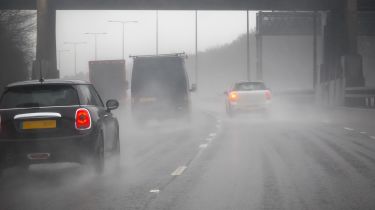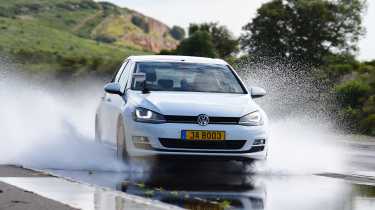What is aquaplaning and how to avoid it
We look at aquaplaning: what it means, how it affects your car and what to do if it happens to you

Rain and Britain go hand in hand, like Spain and sunshine, and things only get wetter when winter comes. Not only does heavy rain reduce visibility and increase braking distances, but it also creates standing water, which can cause your car to aquaplane.
If you’ve ever experienced aquaplaning, either from behind the wheel or the passenger seat, you’ll know how scary it can be. That’s why it’s absolutely vital that you understand what you need to do if you find yourself aquaplaning, and how you can prevent it in the first place. This guide explains everything you need to know about aquaplaning.
What is aquaplaning?
Aquaplaning is a relatively simple concept. It occurs when a layer of water forms between the tread of your tyres and the surface of the road. This breaks contact between the two, meaning your car will stop responding to your inputs, such as braking, steering and acceleration.
The grooves (known as the tread) in your car tyres are designed to dissipate water that is on the road. However, if there’s more water on the road than the tread on your tyres can deal with, there will be a surplus of water that cannot be displaced and the car can start to ride up on it and aquaplane.
Another scenario is when a surplus of water builds up in front of the tyre as you are driving. At this moment, the pressure from the water on the rubber can lift the tyre up, so that it is no longer in contact with the road and the car starts to aquaplane.
Aquaplaning predominantly affects the front wheels because the rears are usually following in the drier tracks left by the front tyres. This means that steering inputs will have no effect and, because a car's brakes are biased to the front, the majority of braking capability will also be lost. The drive will also be affected if you are in a front-wheel-drive car. If all four wheels are separated from the tarmac because of aquaplaning, you have lost control of your vehicle.
What to do if aquaplaning happens?
For those who have not experienced aquaplaning, it will take a second to realise what is happening. The telltale signs are the engine revs spiking (due to the reduced resistance required to make aquaplaning wheels rotate) and the steering becoming much lighter (again, due to less force being required to turn the wheels).
As in so many situations, the worst thing you can do is panic. Mashing the brakes and twirling at the steering wheel will have little effect and could land you in far worse trouble if your car suddenly regains contact with the road.
The best course of action is the following: first, if you’re using cruise control, turn it off at the switch rather than using the brakes, because stepping on the pedal may upset the car’s balance and send you into a spin. Next, gently lift off the throttle; when you aquaplane, your car is essentially a runaway train, so it’s best to let it slow down naturally. When you feel the tyres bite at the road and regain traction, you can then slowly apply the brakes – and don’t forget to breathe!

If your car does not slow sufficiently to regain control or you are approaching a corner, there is very little you can do aside from keep trying the steering and brakes, ensuring each time you are gentle and smooth.
If you wish to perfect your skills, there are several intensive driving courses you can take to gain a better understanding and take control of your vehicle in situations such as this. Experienced instructors will teach you in a controlled environment (such as on a skid pan or racing circuit) how to control understeer or oversteer if your car skids, and regain control of the vehicle if it begins to aquaplane.
What can you do to prevent it from happening?
There are a couple of golden rules to consider when trying to reduce the chances of aquaplaning. Firstly, be aware of the conditions; if there is standing water around or it starts to rain heavily, reduce your speed and take extra care to avoid patches of road that appear to be waterlogged. Slowing down in wet conditions gives your tyres more chance to work, reduces any build-up of excess water and increases the amount of grip available.
After this, there is the condition of your tyres to take into account. Excessively worn or damaged tyres are less efficient at dispersing water from the road, with an increasing drop-off in a tyre's performance as the tread depth approaches the minimum legal limit. Ensuring there is ample tread and that your tyres are inflated to the correct pressure goes a long way towards improving your safety. Even though the minimum tread depth required by law is 1.6mm, leading safety experts recommend a minimum of 2.5mm for winter driving.
Many vehicles – typically high-performance ones – come fitted with summer tyres which, while they provide lots of grip in warm, dry weather, suffer in the wet due to having less tread. For maximum security in colder, wetter months, we recommend fitting a set of all-season or even winter tyres because these typically boast deeper tread and are thus better as dispersing water.
As a last resort, you can, of course, follow the tracks left by the car in front of you. There will be significantly less water for your tyres to remove here, but you must always maintain a safe distance. In wet weather, stopping distances increase dramatically.
Get ready for winter on the roads
Top tips for winter driving
Find a car with the experts





